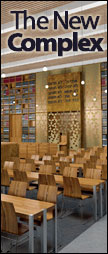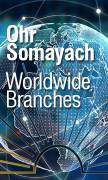Another Kiddush Question: Bentching Repetition Due to Kiddush?
Previous articles addressed the importance of Kiddush B’Makom Seudah– Kiddush needing to being held in the same place as (meaning as part of) a meal.[1] In other words, in order to fulfill the Kiddush obligation, it must serve as the preamble to an actual Seudah.[2] The Rashbam explains that this halacha is gleaned from the pasuk in Yeshaya, ‘V’karasa L’Shabbos Oneg, and you will proclaim Shabbos as a delight for you,’ meaning in the same place where you proclaim Shabbos (making Kiddush), there must also be the delight (referring to celebrating the Shabbos Seudah).[3] This article will discuss a curious corollary – a quite common question that may affect many of us. But first, a bit of background.
What is a Seudah?
Although there is some debate as to how ‘Seudah’ is defined, with the Vilna Gaon famously maintaining that Kiddush may only be performed with a full bread Seudah – meaning exclusively when washing for Hamotzi, nonetheless, the common minhag is to follow the Magen Avraham’s psak, that for this halacha, eating Mezonos is sufficient to be considered a Seudah for Kiddush purposes.[4] In fact, this approachof the Magen Avraham’s was accepted and considered ‘Minhag Yisrael’ by all sectors of world Jewry, certainly for Shabbos day Kiddush.[5] That is why by almost any Kiddush in almost any shul anywhere in the world it is de rigeur to have a Kiddush with minei Mezonos as the Seudah.
A Double Dilemma…
Yet, we find a fascinating corollary to this discussion is another fascinating discussion. As queried by Rav Shimon Sofer HY”D, the renowned Hisorerus Teshuvah, grandson of the Chasam Sofer, and son of the Ksav Sofer, if one already made Kiddush on Mezonos in shul to fulfill ‘Kiddush B’makom Seudah’ and later, upon returning home, has his main Shabbos Seudah, is that main Seudah now considered Seudah Shlishis (‘Shaleshudis’ in the vernacular), or is it still deemed his main Shabbos day Seudah?[6]
Not just a technical question or one of semantics, he posed the question as a potential limud zechus (justification) for those who skip Seudah Shlishis. The upshot is that if one would have already fulfilled his Seudah Shlishis obligation by consuming his main Shabbos Day lunchSeudah, then technically speaking, consuming Seudah Shlishis is no longer strictly necessary. The Hisorerus Teshuvah actuallyasked this question under the title ‘Nistafakti,’ meaning he is uncertain about it and does not have a clear solution.
The Steipler’s Sheilah
The Steipler Gaon[7] cites another practical halachic ramification of this question – if one forgot to recite Retzei as part of Birkas Hamazon. Generally speaking, as one is mandated in eating Seudos on Shabbos, one is therefore obligated to repeat the whole bentching upon omitting Retzei.[8]
Yet, the exception to the rule is Seudah Shlishis. As there is a machlokes Rishonim whether it is strictly necessary to have a bread-based meal for Seudah Shlishis, the Tur concludes tzarich iyun (inconclusively) whether one must repeat Birkas Hamazon upon forgetting Retzei. Practically, the Shulchan Aruch rules that if one completed Bentching of Seudah Shlishis without reciting Retzei, and as opposed to the first two Shabbos Seudos, he should not repeat Bentching, as lemaaseh, Seudah Shlishis shares the halachic status of Rosh Chodesh, when although it is certainly preferential to wash, it is nonetheless not an outright obligation.[9]
So, if one forgot Retzei in Birkas Hamazon in his main Shabbos Day meal, which was after he had already partaken of a ‘Mezonos meal’ Kiddush in shul, the Steipler Gaon maintains that he has unwittingly entered a double dilemma. According to the Vilna Gaon et al., the Mezonos Kiddush in shul was not considered a Seudah. As such, upon omitting Reztei after the main meal, one would certainly be obligated to repeat Bentching, as it is halachically considered his main Shabbos Seudah.
On the other hand, following the mainstream shittah of the Magen Avraham, that the Mezonos Kiddush was considered ‘Kiddush B’makom Seudah,’ it is entirely possible that the Kiddush was already considered his Shabbos Seudah, and the main Seudah following was halachically considered Seudah Shlishis,[10] and thus quite complicated whether or not Birkas Hamazon need be repeated.
The Steipler Gaon concludes that there is no clear-cut solution and ‘l’dina,tzarich iyun gadol.’ Hence, if this happens to you, he advises washing and making Hamotzi again and then making sure to Bentch with Retzei. Utilizing this solution removes all halachic doubt and ensures that there will be nobrachah levatallah.
No Repeating
However, it is reported that later on, after consultation with his venerated brother-in-law, the Chazon Ish, the Steipler Gaon subsequently changed his psak, ruling that lemaaseh it is ‘mestaver’ (stands to reason) that one would have indeed fulfilled his obligation of Seudas Shacharis with Mezonos, and would therefore not repeat Birkas Hamazon for forgetting Retzei at the later full Seudah.[11]
Rav Shlomo Zalman Auerbach is cited by his talmid Rav Avigdor Nebenzahl as ruling similarly: That if one first made Kiddush on Mezonos, and later on at his main Shabbos day Seudah forgot Retzei, then he does not repeat Bentching, as halachically speaking, that Seudah is now considered Seudah Shlishis.[12]
It would seem that the Sanz-Klausenberger Rebbe would certainly agree with this assessment, based on his strong defense of making Kiddush with Lechem Mishneh of Mezonos, stating that M’Deoraysa (Biblically speaking) Mezonos products are considered Pas. If cake is technically deemed an actual ‘bread,’ then one would have certainly have had a ‘Seudah’ by partaking of Kiddush. Indeed, he reports that he often would make a tnai (stipulation), that if he would later not be able to eat Seudah Shlishis, then this Kiddush should be considered his main Shabbos Seudah.[13]
Only the Main Meal
On the other hand, and although not discussing this specific nuance, the Chamudei Efraim, Rav Chaim Efraim Bala’iti HY”D, Mot”z of Taraniya, contends that although one may indeed fulfill his Kiddush B’makom Seudah obligation with Mezonos, nonetheless he needs to have Lechem Mishneh as part of his main Shabbos Day Seudah.
He notes that halachically speaking, if one already made Kiddush earlier with Mezonos, he is technically not required to make Kiddush again at this Seudah.[14] This means that this Kiddush-goer did not have Kiddush B’makom Seudah with Lechem Mishneh – unless halacha considers both his earlier Kiddush, as well as his main Seudah as one (perhaps lengthy) actual Seudah. As such, he is still required to have a separate Seudah Shlishis.
The Chamudei Efraim bolsters his shittah with proof from Tosafos who writes that Mezonos can only be considered as a Seudah on Shabbos for Seudah Shlishis, but not the Friday Night or Shabbos Day Seudos, as they are the ‘ikar kavod Shabbos.’[15] Accordingly, the main Shabbos Day Seudah is considered just that – the main Shabbos Seudah, and hence, if ‘Retzei’ was forgotten, Bentching would need to be repeated.
His son-in-law, Rav Yisrael Veltz (Welcz), Dayan of Budapest, agrees to this principle, but presents entirely different reasoning. He cites the Shaarei Teshuva quoting the Maharshal as to how stringent we must be in observing the chashivus (importance) of the main Shabbos Day Seudah. Rav Veltz asserts that this designation is vis-à-vis Seudah Shlishis, offering support to this distinction from the Shlah, Chasam Sofer, and Likutei Chaver Ben Chaim.
As such, he avers that although one may indeed fulfill his Seudah Shlishis obligation with Mezonos when necessary, nonetheless, one should make sure not to conflate the two Shabbos Seudos. In his words, “ain laasos hatafel l’ikar v’ikar l’tafel,le’echol b’Seudah Shniyah pas v’kaffe,uv’Shlishis bassar v’dagim… d’Seudas Shabbos tzarich Hamotzi u’Birkas Hamazon… d’pshita af l’osan haPoskim d’Seudah Shlishis yotzim b’minei targima,aval rak achar Seudah Shniyah B’Shabbos shehu ikar,” one should not turn the ikar tafel (primary into secondary) and the tafel ikar (or vice versa) – by having cake and coffee for one’s main Shabbos Seudah and reserving the fish and meat for Seudah Shlishis. Although there is a dispensation to fulfill Seudah Shlishis with simple Mezonos, this is exclusively after first fulfilling one’s main Shabbos Seudah obligation.[16]
SeudahBy Chatzos
This understanding also bears out from the Aruch Hashulchan’s shittah regarding the halacha of not fasting on Shabbos or Yom Tov. He explains that although one who drinks a hot drink on Shabbos morning before davening or (even better) makes Kiddush on Mezonos after davening is technically ‘not fasting,’ nonetheless, optimally, one should still strive to start his full Hamotzi Seudah before Chatzos, as Chazal established the morning Seudah to be held specifically then – while it is still ‘morning.’[17]
It seems clear from the Aruch Hashulchan’s wording that he holds that a Shabbos morning Kiddush, although considered ‘Makom Seudah,’ nonetheless does not count as the real Seudah. In fact, he refers to it ‘toamin m’taamas,’ mere tasting, even while ‘achal k’zayis,’ consuming a proper shiur of Mezonos. Indeed, earlier on, he clearly states that although the minhag is to make Kiddush with Mezonos, it is nonetheless preferable to make ‘Seudas Shabbos B’Shleimus, d’zehu Ikar Kiddush B’Makom Seudah,” the full Shabbos Seudah, as that is the primaryKiddush B’Makom Seudah.[18]
Accordingly, it would seem that these esteemed Poskim would be of the opinion that if one would have made Kiddush and later on had the Seudah, they would not consider that Seudah as Seudah Shlishis, but rather the main Shabbos Seudah, and hence, accordingly would maintain that Retzei would need to be repeated if forgotten in Bentching.
Although there does not seem to be a clear consensus or conclusion to this confounding conundrum, and if one forgot Retzei in Birkas Hamazon at the Shabbos day Seudah the Steipler’s advice of washing and Bentching again would certainly be prudent, either way, at least we now have some more ‘food for thought’ for the next Kiddush. After all, if a shul Kiddush can be deemed a Seudah, then surely Divrei Torah would be appropriate to be ‘served.’[19]
Written L’Refuah Sheleimah for R’ Avrohom Yaakov Abbish ben Chana Rivka and Rav Yair Nissan ben Sarah and L’Iluy Nishmas the Rosh Yeshiva Rav Nosson Nota ben Avraham Yitzchak (Schiller)
Rabbi Yehuda Spitz, author of M’Shulchan Yehuda on Inyanei Halacha, serves as the Sho’el U'Meishiv and Rosh Chabura of the Ohr Lagolah Halacha Kollel at Yeshivas Ohr Somayach in Yerushalayim and the author of the Insights Into Halachacolumn.
His recent English halacha sefer, “Insights Into Halacha - Food: A Halachic Analysis,” (Mosaica/Feldheim) contains more than 500 pages and features over 30 comprehensive chapters discussing a myriad of halachic issues relating to food. It is now available online and in bookstores everywhere.
For any questions, comments or for the full Mareh Mekomos / sources, please email the author: yspitz@ohr.edu.
[1]‘Common Kiddush Questions,’ ‘More Common Kiddush Questions: Kiddush Bemakom Seudah,’ and ‘An Uncommon Kiddush Question: Lechem Mishneh With Mezonos?’
[2]Gemara Pesachim (101a). See Rif (Pesachim 20a), Rosh (ad loc. Ch. 10:5), Tosafos (ad loc. 100b s.v. yedei Kiddush), Rambam (Hilchos Shabbos, Ch. 29:8 and 10), and Tur and Shulchan Aruch (Orach Chaim 273: 1).
[3]Rashbam (ad loc. s.v. af) citing Yeshaya (Ch. 58: 13).
[4]Maaseh Rav (122; also cited in Biur Halacha (275:5 s.v. kasvu), and Magen Avraham (Orach Chaim 273:11).
[5]See Shu”t Ginas Veradim (Orach Chaim 3:12), Birkei Yosef (Orach Chaim 273:2 and 6), Be’er Heitiv (ad loc. 7), Shaarei Teshuva (ad loc. 7), Shulchan Aruch Harav (ad loc. 7; interestingly, in the next siman 274:5, he writes that even so, one must have another Seudah on bread, as the Mezonos at a Kiddush does not constitute a meal to fulfill one of his three Shabbos Seudah obligations), Pri Megadim (ad loc. Eishel Avraham 11), Chayei Adam (vol. 2, 6:22), Matteh Efraim (597: 2), Kitzur Shulchan Aruch (77: 14), Ben Ish Chai (Year 2, Parashas Bereishis 7), Aruch Hashulchan (Orach Chaim 273:8), Mishnah Berurah (ad loc. 25), and Kaf Hachaim (ad loc. 41). Many contemporary poskim as well, including Rav Shlomo Zalman Auerbach (see Halichos Shlomo on Moadim vol. 1, Ch. 1: footnote 72 and Va’aleihu Lo Yibol vol. 1, pg. 141), Rav Yosef Shalom Elyashiv (Kovetz Teshuvos vol. 1:24 s.v. umei), the Minchas Yitzchak (Shu”t vol. 3:13, 7), Rav Yisrael Yaakov Fischer (Halichos Even Yisrael, Shabbos vol. 1, Ch. 14:9 and 25:3), and Rav Moshe Feinstein (Shu”t Igros Moshe, Orach Chaim vol. 4:63, 7 and 8; see also Shu”t Vedibarta Bam vol. 1:72; quoting Rav Dovid Feinstein), rule that the ikar halacha follows the ruling of the Magen Avraham that one may lechatchillah make Kiddush with Minei Mezonos.
[6]Shu”t Hisorerus Teshuva (vol. 1:74).
[7]Kehillas Yaakov (Brachos 25; 16 in the old print; see also Rav Asher Sonnenfeld’s recent Shaarei Osher on Chagim U’Zmanim vol. 3:22 s.v. u’tfei and 110, and Shaarei Osher on Chag HaPesach 44).
[8]See Tur and Shulchan Aruch (O.C. 188:5-6) andShu”t Rabbi Akiva Eiger (vol. 1:1). This was discussed at length in a previous article titled ‘Facts and Formulae for the Forgetful.’
[9]Tur and Shulchan Aruch (O.C. 188:8). Although the Tur himself, as well as the Shulchan Aruch (O.C. 291:4 and 5), conclude that optimally one should indeed wash for Seudah Shlishis, due to the three times the Torah states ‘Hayom’ in the Parashas HaMunn.
[10]Although the Rema (O.C. 291:2) concludes that lechatchilla one should daven Mincha prior to eating Seudah Shlishis, nevertheless, one m’dina is still yotzei his chiyuv after Zman Mincha Gedolah.
[11]Orchos Rabbeinu(new edition; vol. 1, pg. 237:8).
[12]B’Yitzchak Yikarei on the Mishnah Berurah (273:28; thanks are due to R’ Yosef Tradburks for pointing this out).
[13]Shu”t Divrei Yatziv (O.C. vol. 1:127). This was detailed at length in a previous article titled ‘An Uncommon Kiddush Question: Lechem Mishneh With Mezonos?’
[14]Although many indeed are makpid to make Kiddush again as part of their main Seudah in order to be Yotzai thechiyuv ofKiddush B’Makom Seudah according to all opinions. This was discussed at length in a previous article titled ‘More Common Kiddush Questions: Kiddush Bemakom Seudah.’ See Shu”t Salmas Chaim (old print vol. 1:59; new print Orach Chaim 255), Shu”t Igros Moshe (Orach Chaim vol. 4:63, 7 and 8), Shu”t Teshuvos V’Hanhagos (vol. 1:264), Moadim U’Zmanim (vol. 3:243), Machaneh Chaim (Kuntress Darchei Chaim, 5 s.v. Shabato; thanks are due to Rav Efraim Landy, Rav of Aderes Eliyahu in Givat Zev, for pointing this out), Yerushalayim B’Moadeha (Shabbos vol. 2:124; citing Rav Shlomo Zalman Auerbach), Kovetz Kol HaTorah (vol. 42, Nissan 5757, pg. 22:22; ‘Leket mei’Hanhagos v’Hora’os HaGaava”d zt”l [Minchas Yitzchak] B’Inyanei Hilchos Shabbos’), Shu”t Betzeil Hachochma (vol. 5:117), Shu”t Vedibarta Bam (vol. 1:72; citing Rav Dovid Feinstein), and Rav Herchel Schachter’s Eretz HaTzvi (5: end 10 s.v. ulefi divrei Rabbeinu).
[15]Shu”t Chamudei Efraim (new edition 9; old edition Eishel Efraim vol. 2, Kuntress Chaim Sha’al 1), citing Tosafos (Pesachim 101a s.v. ta’imo).
[16]Shu”t Divrei Yisrael (vol. 1, O.C. 86), citing the Shaarei Teshuva (O.C. 271:1) quoting the Maharshal (Yam Shel Shlomo,Gittin Ch. 4:51).This shittah further bears out from Rav Veltz’s Chok L’Yisrael on Erev Pesach Shechal B’Shabbos (footnote 79), who cites the Maharsham’s arguing on the Kitzur Shulchan Aruch and further assertion that one should specifically not make Kiddush with Lechem Mishneh of Mezonos as then he may have to halachically wash and bentch (this machlokes was detailed at length in last week’s article titled ‘An Uncommon Kiddush Question: Lechem Mishneh With Mezonos?’), as a potential solution on Erev Pesach Shechal B’Shabbos. He explains that this facilitates an easier way to have split Seudos on this Shabbos morning before Sof Zman Achillas Chometz, which many Poskim, himself included, maintain is the preferred option on Erev Pesach Shechal B’Shabbos. He asserts that if one would make Kiddush with Lechem Mishneh of Mezonos (i.e. two Rugelach) along with some Maachalei Chalav, it would then technically fully count as one of the Shabbos Seudos, even though it only constituted a small Kiddush, thus easier enabling another Seudah before Sof Zman Achillas Chometz. But this rationale is only valid because Rav Veltz understood that in this instance, following the Maharsham’s approach, one would have actually been required to wash and bentch for this Kiddush ‘Seudah.’ This proves that he is of the opinion that otherwise, a simple Shabbos morning Kiddush would certainly not be considered an actual Seudah. However, it must be noted that this approach is quite novel (in fact, this author has not seen a single other Posek advise this), and especially as the Maharsham seemingly only stated this complicated combination rationale theoretically, and exclusively to argue on the Kitzur Shulchan Aruch’s premise; not that people should act upon it practically.
[17]Aruch Hashulchan (O.C.288:1-2).Thanks are due to my father, renowned kashrus expert Rav Manish Spitz, for pointing this application out. See also Rav Shmuel Kamenetzky’s Kovetz Halachos (Shabbos vol. 1, Ch. 14:2), where not only is he makpid for this shittah that lechatchilla the actual Shabbos Seudah should begin before Chatzos, but also in the footnotes extensively asserts that this is also truly the opinion of many other Poskim, including the Bach, Pri Megadim, and Mishnah Berurah (although he admits that there seems to be a stirah in the psakim of the Pri Megadim and Mishnah Berurah regarding this inyan), although they do not outright state this, as does the Aruch Hashulchan.
[18]Aruch Hashulchan (O.C. 273:8).
[19]See Pirkei Avos (Ch. 3, Mishnah 3).
Disclaimer: This is not a comprehensive guide, rather a brief summary to raise awareness of the issues. In any real case one should ask a competent Halachic authority.
L'iluy Nishmas the Rosh HaYeshiva - Rav Chonoh Menachem Mendel ben R' Yechezkel Shraga, Rav Yaakov Yeshaya ben R' Boruch Yehuda.






